It was a cold winter day when the wind blew the snow off the tall trees on the Manitoulin Island, stretched in the middle of Lake Huron in Ontario. The air was chilly, so Joseph Shawana and a few other kids from the Odawa tribe were playing underneath the low sprawling branches of a spruce tree, sheltering from the wind. They snuggled up together, breathing in the scent of the frozen forest, and ate the crust off the snow. It melted in their mouths like crunchy sugarless ice cream, spiced by the chewy green needles fallen off the tree. That flavor was yet another childhood memory Shawana would forget … until he resurrected it years later, in his mid-30s while designing a menu for his restaurant in Toronto.
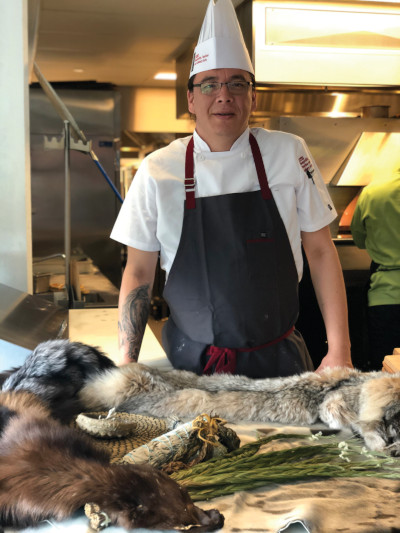
Kitchen. For generations, being indigenous in Canada came with a stigma. Today, pride of tribal culture is returning and people no longer feel the need to hide their roots, as Shawana did for most of his life.(Photo by Rebecca McKenzie)
There are many things 38-year-old Shawana still does not remember about growing up in the Manitoulin Island’s Wiikwemkoong Unceded Reserve. But what he does remember are the smells, tastes, and textures of foods his family cooked. He remembers watching his mom and grandmother making food — mixing dough with flour made from ground roots of sunchokes or stirring soup cooked from cabbage and corn over an open fire set behind the house. He remembers smoking meat carved from a moose that his grandfather had hunted and brought home only hours before. As a child, he foraged, fished, and picked baskets of blueberries for his grandmother to make into pies. On a few occasions he went hunting with his grandfather too, but generally he preferred to stay in the kitchen helping the women. “I don’t know how my mother managed to raise all six of us. My father left when I was quite young and we didn’t have much money,” he recalls. “So we would eat off the land, picking apples and berries and chewing on the outside of the cedars. There’s a membrane on the cedar tree that tastes really sweet, almost like candy. We liked to chew on it when we were kids.”
We would eat off the land, picking apples and berries and chewing on the outside of the cedars. There’s a membrane on the cedar tree that tastes really sweet, almost like candy.”
Back in the day, foraging and open fire cooking wasn’t something Shawana would talk about much. That meant admitting that he was an indigenous person who grew up “in the bush,” hunting game, and essentially leading a subsistence lifestyle. For generations, being indigenous in Canada came with a stigma. Like many indigenous tribes in the United States, Canadian First Nations have endured generational mistreatment, says Lenore Newman, who directs the Food and Agriculture Institute at the University of the Fraser Valley. The hard times started when the country’s first prime minister, John Alexander Macdonald, effectively eliminated the history of indigenous people in the late 1800s by eliminating what they ate. “He used food as a weapon and killed the bison, essentially starving them,” says Newman, author of Lost Feast: Culinary Extinction and the Future of Food.
Things went downhill from there. “There was a program run by the Catholic church in which young people were taken from families and shipped off to residential schools, where they were abused, starved, and died of disease,” Newman says. “They were discouraged from speaking their language and eating their food. This generational violence continued all the way into the 1990s. It did a number on the culture, and a lot of traditions and foods were lost.”
To correct these historic wrongs, in 2008, Canada’s prime minister Stephen Harper apologized to the indigenous population for the residential school program that aimed to forcibly assimilate them into the European way of living. In 2017, current prime minster Justin Trudeau further apologized for the profound cultural loss. And the tide began to turn. Being Odawa, Cree, Innu, or Haida Gwaii was no longer such a stigma. So people became more vocal about their cultures and where they came from. Suddenly indigenous chefs were opening restaurants across the country, winning awards and making headlines.
That trend isn’t as strong in the United States, although there are some wonderful and creative sparks if you know where to look (see the sidebar “Taste It Yourself!”). The difference is that the Canadian government stepped in to help shift the mindset of its own First Nations people from shame to pride, Newman says. “The interest in the food has risen with the government apologies and the formal process of reconciliation in Canada.” When that happened, the public’s interest in indigenous food soared. In just a few years it went from being almost taboo to even talk about to something to be a proud of, Shawana says. People no longer try to hide their roots, as he did for most of his life. “I was ashamed. I didn’t feel as open as I am now, as confident as I am now talking about our foods.”
Today, in Canada, indigenous cuisine is not only accepted, it’s trendy. Canadians regard it as original and authentic, something to celebrate and showcase. So Canadian indigenous chefs are doing just that. This past March, days before the world went into lockdown, Shawana was cooking at the Restaurants Canada three-day Toronto event with two other indigenous chefs, Marie-Cecile Nottaway from Quebec and Christa Bruneau-Guenther from Manitoba. All three brought their own specialty recipes — some passed down from their grandmothers and others re-created based on ingredients their tribes foraged for centuries before the Europeans arrived. And as they cooked together, simmering smoked deer in a tea reduction, frying cornbread with blueberry cream glaze, and thickening maple syrup toffee, they told stories of their culture, history, and the various paths that brought them together under the spotlight at Canada’s biggest annual food and hospitality event.
Shawana, who bears his tribe’s name Odawa tattooed on his left arm and keeps his waist-length hair gathered in a braid or two, learned to cook from his mother and grandmothers. He began experimenting with his own dishes when he was a teenager. “The first dish I cooked by myself was a roasted pork shoulder with root vegetables. It’s a very wintery dish because you can store the roots all winter long,” he explains. “I still make it the same way.”
Later, he took a burger-flipping job at a restaurant on the Manitoulin Island, feeding nature-seekers from urban centers like Toronto. But after SARS hit the area hard in 2003, tourism dried up and he moved to Toronto himself. For a brief period, he studied at a culinary school while trying to make ends meet working two jobs. He soon dropped out, choosing to learn his craft by working alongside experienced chefs.
Suddenly indigenous chefs were opening restaurants across the country, winning awards and making headlines.
In 2017, he opened Kū-Kŭm Kitchen — “Grandmother’s Kitchen” in Cree — in Toronto, making fusion dishes using indigenous ingredients with French techniques. He served Chinook salmon, bison, and seal loin raw as Trio of Tartare, elk cooked sous vide, and venison stews. The foodies and critics loved the concept, and Kū-Kŭm soared to stardom fast. The Toronto Star profiled him as the indigenous chef cooking with a “French accent.” Canadian Airline’s enRoute magazine featured him as well. “We made Top 20 Chefs in Canada two years in a row,” Shawana recalls.
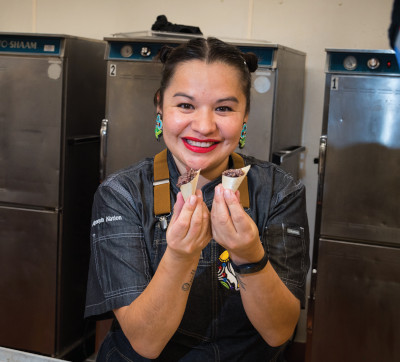
(Simon Sees Photography)
Marie-Cecile Nottaway grew up knowing she had to catch her food before she could cook it. “I grew up bush-cooking,” she says with undisguised pride while tirelessly stirring the slowly congealing maple syrup goo in the pan — her grandmother’s toffee recipe. By the time she was eight years old, she was already a pro at setting up rabbit snares around the Parc de la Vérendrye in Quebec where she lived. “I would do my two- to three-kilometer trek in my snow shoes in the morning, after breakfast, and set them up. Then the next day I’d go over my tracks to check them, and sometimes I’d come back with two or three rabbits!”
The wolves were out there looking for rabbits too, but she wasn’t scared of them, she says. When it was suggested that she take a dog with her for protection, she refused, fearing the dog would scare off the rabbits. Back then, she explains, rabbits weren’t just food, they were a currency, a way to earn respect. “The rabbit head was a delicacy,” she says. “If I got a rabbit, I got to decide who gets to eat the head, so I’d give it to someone who was nice to me.”
She recalls that in summers her family would forage for blueberries, gathering up brimming baskets still warm from the sun. “It was the thing to do in the summer. My family would set up a tent and we’d pick, pick, pick, for three or four weeks, the entire season,” she recalls, her dark brown eyes sparkling with joy at the memory. “We sold them for $15 a basket! That was a lot of money!”
Nottaway’s first cooking experience proved harder than snaring rabbits. She poured too much oil onto a pan and overheated it, so when she cracked an egg into the pan, the oil splattered all over and burnt her. In school, her teacher pulled her up to the front of the class, humiliating her in front of her schoolmates by pointing out her burn mark. “That’s why you don’t cook alone,” she said. Nottaway vowed then and there to learn to be a chef, if only to prove the teacher wrong. “I am a cook, and I’ll show you that I am,” she remembers thinking.
One of the first cooking skills she learned was cleaning fish — piles and piles of fish. “We’d have huge containers full of them and we stunk of fish by the time we were done,” she says, laughing. But working that knife for hours at a time allowed her to perfect her skills. Today, she says she could fillet a fish with her eyes closed. One of her signature dishes is fish balls, a dish made from carp, a tasty creature that is difficult to debone. Nottaway expertly removes the big bones and puts the flesh through a meat grinder, which mills the smaller bones to mush. “Then I roll it into balls and fry them,” she says, with the tiny bone fragments adding to the crunch. “My freezer’s always full of them — we go fishing for carp every summer.”
Nottaway trained at a French cooking school, but when it comes to catching carp, she relies on the old ways, catching them by hand, a knack she learned early in life and passed along to her own two children. When carp spawn, they travel along the river in such huge numbers that the water gets thick with them. If you dip your hands into the water around one gently and then bring your hands together fast, the carp is yours. You do it all day long and you’ll have enough fish to freeze for a year, not only for the family but for Nottaway’s business, Wawatay Catering — wawatay is an Algonquin name for the Northern Lights.
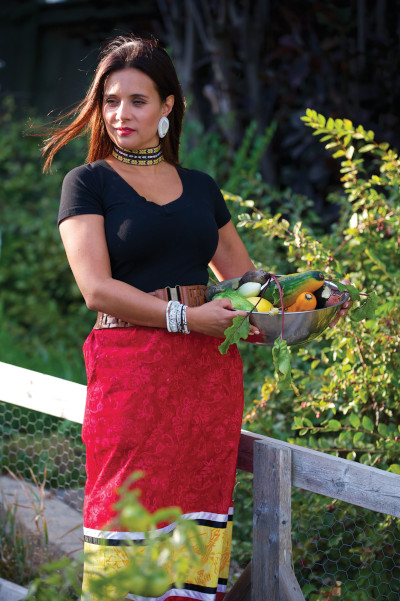
For her part, Christa Bruneau-Guenther grew up in the city and poor, so she learned to make ends meet by growing food in her family’s garden. Eating a carrot meant pulling it out of the ground, wiping it off, and eating it crunchy with dirt, she recalls with a smile. She would also salvage fruit going to rot in neighbors’ yards. “People had apple and plum trees, and a lot of the fruit would just be lying there on the ground. I used to knock on people’s doors and ask them to let me pick the fruit they wouldn’t use,” she recalls. “I’d pick it, clean it, set up a table on a corner and try to sell some. What I couldn’t sell, I’d bake with. And I’d give some away.” She never thought she’d be a chef, but food proved to be a meal ticket. “If I wanted to buy anything for myself, I’d have to make that money first. Babysitting was one way to earn money, and food was another.”
She started as a server in a restaurant, and later operated a day care center.
“I was a home cook. I never trained to be a chef,” she chuckles. Yet today she owns Feast Café Bistro in Winnipeg, with 23 employees she treats like family members. Many of them never cooked before: They grew up eating bologna and canned beans bought with social assistance money. They were so disconnected from their roots that they couldn’t possibly learn how to make traditional foods — so much of the original recipes were lost, forgotten, extinguished. At the Bistro they are rediscovering themselves and their heritage through dishes, recipes, and vegetables native to their land, and through the love that goes into turning Mother Nature’s bounty into a feast. “Those people never had a job before, and now they’re off social assistance and they are supporting themselves and their children,” Bruneau-Guenther says.
The Indigenous Culinary of Associated Nations, of which Shawana is acting chair, is working to attract more young people to culinary schools and to set up indigenous cooking curricula for them. And now that indigenous cooking has become chic, even those who considered themselves “European Canadians” are rediscovering their roots — or resurrecting them from decades’ worth of oblivion.
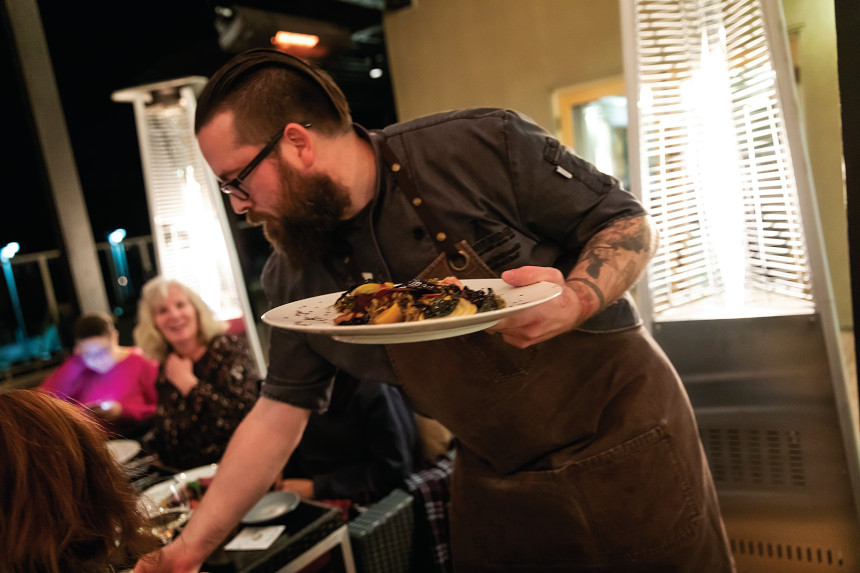
(Simon Sees Photography)
Chef Murray McDonald did not know about his indigenous heritage. Growing up in Deer Lakes, Newfoundland, he hunted like everyone else in town, but considered himself to be of European descent. As an adult, he learned that his great-grandmother was an Innu, taken from her family as part of the government programs. She married an Englishman, so her family history was lost. “Growing up in rural Newfoundland, that wasn’t something we talked about,” McDonald says. Years later, after he’d worked as a chef all over the world, he came back home to Newfoundland’s Fogo Island, where he crafted a menu featuring caribou, moose, and bear. As he cooked game on open fire and foraged for herbs in the forest, his assistant, a Mi’kmaq from Prince Edward Island, observed in surprise, “Chef, you’re cooking indigenous!” McDonald pondered the comment. “I realized he was right, I was using indigenous techniques. Those were the foods I liked to eat, so I think it was always in my DNA.”
Today McDonald runs The Bear, the Fish, the Root and the Berry, a restaurant whose name references the native’s four food staples. Located on the traditional land of the Syilx People of the Okanagan Nation in Osoyoos, British Columbia, it serves indigenous-inspired dishes, from bison burgers to vegan salads of squash, corn, and seeds. We tend to think of indigenous cuisine as meat-focused, but the tribes always relied on edible plants that some foraged and others grew. Newman says, “On the west coast, they planted fields of various crops like springbank clover and camas lily, which we don’t eat, but they did. They also did clam gardening and they kept oysters.” Those were healthy, nutritious foods that First Nations needed to survive in harsh weather.
When Shawana decided to cook only with indigenous, precolonial ingredients — absent dairy, sugar, and European grains — he started to feel different. “I lost weight, became more energetic, and my complexion cleared,” he says. “I think we weren’t meant to eat those foods.” So he began to convert Kū-Kŭm’s menu, which had originally featured only a few indigenous foods, to indigenous only — for example, replacing chicken eggs with duck eggs and sugar with maple syrup. He also began talking to the elders in the community, trying to bring back the memories of what ancestral foods they could recall. “A lot of native communities lost their language, and if we lose our foods it’s another piece of identity we won’t have,” Shawana says.
“A lot of native communities lost their language, and if we lose our foods it’s another piece of identity we won’t have.”
Food also is the social glue that holds society together, Newman agrees, pointing out that people celebrate through food, overcome grief with food, and bond via food. “Food is critical to culture because cuisine is language,” she says. “We explore cultures through cuisines, and we learn about people’s lives by what they eat.”
Switching to fully indigenous did just that for Shawana; it brought back lost childhood memories, too. One day, while developing a dessert for Kū-Kŭm, he tossed maple syrup and water into a pot and threw a few pine needles into the mix. He simmered the blend for about 20 minutes and then strained it and cooled it off. He used an ice-cream machine to create a sorbet from his brew, without adding any flour or milk. The first time he nibbled at his creation, the cold morsel melted in his mouth, evoking the fresh pine needles collected with snow crust that he used to gnaw at underneath the cedar trees with his friends. “The dessert was not inspired by that memory — on the contrary, it gave me my memory back,” Shawana says. It was as if he was a child once again, but in a happier place. In a place where he didn’t have to be ashamed of who he was and of the food he made.
Lina Zeldovich fished for piranhas in Brazil, cooked a zebu stew in Madagascar, sipped a drink made from a Peruvian viper — and always lived to write the story. She has written for Reader’s Digest, Sierra Club, Audubon, and Scientific American, among others. Her book The Other Dark Matter: The Science and Business of Turning Waste into Wealth and Health will be published by Chicago University Press in 2021.
This is an abridged version of of an article from the November/December 2020 issue of The Saturday Evening Post. Subscribe to the magazine for more art, inspiring stories, fiction, humor, and features from our archives.
Featured image: Joseph Shawana
Become a Saturday Evening Post member and enjoy unlimited access. Subscribe now
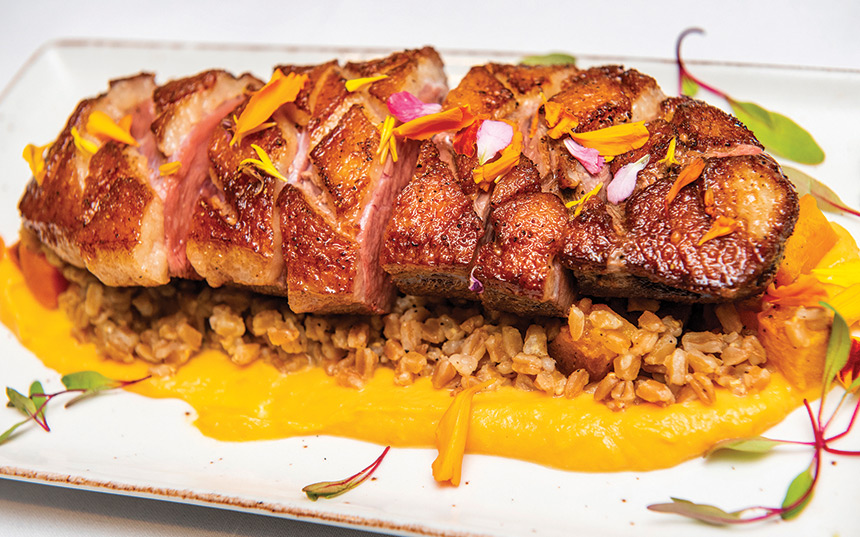
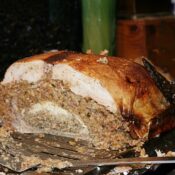
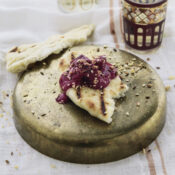

Comments
@rick baldwin that’s a very rude way to talk about your great grandmother.
My great grandmother was a squaw and
the best thing that ever happened to her was
my ancestral trapper taking her out of the woods
and into civilization.Living off the land is hard,
one flood,one frost and all is lost.